Top News
September 24, 2013 Ryukyu Shimpo
The Okinawa Defense Bureau has confirmed that in 2012, for the first time in three years, dugongs came to feed in the sea off Henoko in Nago. This area is the site of the planned reclamation for the relocation of U.S. Marine Corps Air Station Futenma. Records obtained by Kyodo News through a freedom-of-information request suggest that there was evidence of seaweed having been eaten by the endangered marine species. Despite this, without disclosing this to the public, the Defense Bureau applied for a landfill permit in March saying the plan would have little impact on the environment. The Ministry of Defense commented that they never intended to make the results of the survey public, but this statement represents an outrageous lack of common sense. Under the constitution, the people have a right to be informed. In keeping with the principles of the Freedom of Information Act the government should disclose any information that it has. The Ministry of Defense is also known for its tendency towards secrecy. Not only does this serve no purpose, but it flies in the face of democracy, the Constitution and the obligation of civil servants or government employees to abide by the Constitution. We urge them to take this seriously.
According to the report, between April and June last year the Ministry confirmed a dozen instances of seaweed having been eaten by dugongs at the site. There had been no other traces of seaweed having been eaten by the mammals near the area since June 2009. The area around Henoko is known as the habitat for blue coral, an endangered species, and as where sea turtles lay their eggs. The Nature Conservation Society of Japan has confirmed that seven varieties of seaweed, semi-endangered species in the Red Data Book of the Ministry of the Environment, are found there. Three times in the past, the International Union for Conservation of Nature (IUCN) has recommended action to save the dugongs. That Japan and the United States continue to ignore this recommendation is sinful in the extreme.
The marine ecology has been damaged by a range of complicated problems including bleaching of coral reefs due to the rise in ocean temperatures, the resulting disturbance of the ecosystem, the depletion of fishery resources associated with the overfishing of bluefin tuna and the outflow of contaminated water due to the Fukushima Daiichi nuclear accident.
That they are prepared to cause damage to the sea in order to build a military base is contrary to the global trend of strengthening environmental protection policies. Government officials should feel pangs of conscience for what they are doing to the sea, which is so valuable and rich in biodiversity.
Former Defense Minister Satoshi Morimoto has pointed out that from a military perspective there are no reasonable grounds for relocating the Futenma base within Okinawa. In the near future, Okinawa Governor Hirokazu Nakaima will decide whether or not to approve the landfill, but either way, the leaders of Japan and the United States should cancel the Henoko plan. It runs contrary to global trends toward protection of the environment, and has neither military rationality nor support from the Okinawan public. Both governments should look to consider this issue from a different angle and see the closing of the Futenma base as an opportunity to drastically improve Japan-U.S. relations.
(English translation by T&CT, Mark Ealey)
Go to Japanese
September 18, 2013 Ryukyu Shimpo
On September 17, the Okinawa Prefectural Government announced the economic ripple effect of tourism in Okinawa in the 2012 fiscal year. With increasing numbers of tourists from overseas, this business produced a ripple effect worth 676.7 billion yen in 2012, up 2.3 percent from 2009. The number of foreign tourists increased with low-cost carriers coming into service and with the expansion of overseas airline routes and the increase in the number of ports of call by large cruise ships. Tourism spending, used as the basis of the calculation of the economic ripple effect, was 457.6 billion yen, up 3.6 percent from that in 2009.
The economic ripple effect mainly affects the accommodation and restaurant industries directly involved with tourists. Direct and indirect employment effects on tourism reached 81,041 people, an increase of 2 percent from that in 2009. This is equivalent to 12.9 percent of employed workers in Okinawa.
This survey started in fiscal year 2004 and is conducted every five years, but will be carried out every year after 2012. The economic ripple effect includes direct, primary and secondary effects from tourism expenditure.
Tourism expenditure is calculated by multiplying the number of tourists within Okinawa and from other prefectures and overseas by 67,459 yen (an average visitor’s spending). Tourist spending from other prefectures was 376.9 billion yen, an increase of 2.7 percent on 2009, and that from abroad 22.7 billion yen, an increase of 2.1 times on 2009. Local people’s spending was 57.9 billion yen, a decrease of 9.4 percent. The added value effect, including employee income and corporate profits, reached 649.6 billion yen. This represents 9.3 percent of the fiscal 2010 prefectural gross product, which was 3 trillion 725.5 billion yen.
Tsuyoshi Murayama, the chief of the Tourism Policy Division of the Okinawa Prefectural Government said, “We want to promote tourism more actively to attract more people in future.”
(English translation by T&CT, Hitomi Shinzato and Mark Ealey)
Go to Japanese
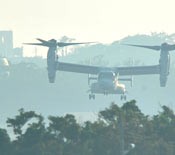
September 26, 2013 Ryukyu Shimpo
The U.S. Marine Corps has completed moving 12 another MV-22 Osprey aircraft from Iwakuni Air Station to Okinawa. The last aircraft arrived at U.S. Marine Corps Air Station Futenma in the evening of September 25. The U.S. military has now stationed 24 Osprey there, following on from the deployment of the first squadron of 12 aircraft last October. Training will proceed in Okinawa involving all 24 Osprey, further heightening fears of the local people about the aircraft. This will also lead to further opposition to the military’s move.
According to the Ginowan City Government, the last aircraft took off from Iwakuni Air Station around 3:00 p.m. on September 25. It had arrived at Futenma Air Station by 5:20 p.m. after having been seen flying over Naha City.
The military brought another 12 Osprey to Iwakuni in July, before moving 11 of them to Futenma on August 3 and 12. The departure of the last aircraft from Iwakuni was delayed because of a technical issue.
Okinawa Governor Hirokazu Nakaima once again opposed the deployment of another Osprey squadron to Okinawa, saying, “The military has not dispelled the concerns of the people about the safety of this aircraft.” He continued, “I want the military to adhere to what the Japan-U.S. Joint Committee decided.” Nakaima suggested that the military should deploy the Osprey in various parts of the main islands of Japan.
(English translation by T&CT, Mark Ealey)
Go to Japanese
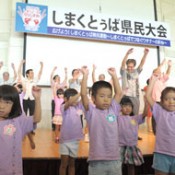
September 19, 2013 Ryukyu Shimpo
The Okinawa Prefectural Government held the first Shimakutuba Citizens’ Rally at the Okinawa Convention Center Conference Building in Ginowan City on September 18. The aim of the rally was to encourage Okinawan people to be become interested in Shimakutuba (Ryukyuan languages) and to promote a deeper understanding of the subject. It was also designed to help pass the languages on to future generations. About 570 people, including junior high school and high school students, took part in the rally. The government presented a 10-year plan to promote the use of Shimakutuba and participants declared they will work on promoting the languages in Okinawan society.
Okinawa Governor Hirokazu Nakaima said, “The languages that Okinawan people have been passing down in each community are the basis of Okinawan culture. They identify Okinawa. We want to pass on our culture to future generations.”
Vice Governor Kurayoshi Takara said in Shimakutuba, “Please take good care of Shimakutuba.”
The Okinawa Prefectural Assembly Chairman Masaharu Kina gave a 10-minute speech in the Okinawan dialect for the first time. He talked about when the assembly set up Shimakutuba Day in 2006, saying, “It is important that momentum has grown to reach what we have today. I hope that people start using Shimakutuba at home.”
Okinawa Monorail, Japan Transocean Air, Daiichi Kotsu, and the Nakijin Village Culture Association also presented projects to promote the languages. The rally introduced Shimakutuba Radio Exercise with kindergarten pupils and songs designed to promote the languages.
A government public opinion survey on Shimakutuba indicates that while 80 percent of Okinawan people feel familiar with the languages, only 10 percent use the languages. UNESCO has recognised the Ryukyuan languages as being endangered and passing them on has become an important issue. The government plans to continue holding this rally every year.
(English translation by T&CT, Megumi Chibana and Mark Ealey)
Go to Japanese

Go To Video
September 20, 2013 Ryota Nakamura of Ryukyu Shimpo
The Nago City Office has decided to sign up to the think tank New Diplomacy Initiative, which sends out information and makes policy recommendations between Japan and the United States. It is rare for a municipal office in Japan to become involved in a diplomatic think tank. By signing up, the city office aims to gather information from sources other than existing media and diplomatic channels and to disseminate information itself.
The city office plans to sign up as a group member this October. In February 2012, Mayor Susumu Inamine visited the United States to state his opposition to moving the facilities currently at U.S. Marine Corps Air Station Futenma to Henoko in Nago. During his visit, he came to understand that American people are not aware of Okinawan issues. The city office started thinking about ways to set up a network with the American side and to collect the latest information from the United States.
A representative of the think tank said that they will support Mayor Inamine when he visits the United States and will help the city convey information to the United States. Director of the think tank, Sayo Saruta, helped with the mayor’s visit to the United States last year.
Established in August, the think tank’s main objective is to take normally unheard voices to where diplomacy occurs. Board members include Japanese journalist Shuntaro Torigoe, professor of Tokyo University Kiichi Fujiwara, professor of George Washington University Mike M. Mochizuki, and professor of Hokkaido University Jiro Yamaguchi.
Koichiro Nakazato, the Chief of the Public Relations and Liaison Division of the city said, “Signing up with New Diplomacy Initiative is valuable for Nago because we are in a position in which we must make a broad range of judgments on U.S. military base issues.”
(English translation by T&CT, Lima Tokumori and Mark Ealey)
Glossary: New Diplomacy Initiative
A research institute that makes policy recommendations to accurately represent various opinions in Okinawa and Japan to the United States. They work to deliver information about U.S. military base issues in Okinawa, such as the land reclamation off Henoko, Nago in preparation for moving the facilities at U.S. Marine Corps Air Station Futenma. They approach governments, legislatures, universities, nongovernmental organizations and mass media organizations in Japan and beyond in order to influence policy decisions. They hold symposiums, gather information and lobby.
Go to Japanese
September 23, 2013 Ken Sasaki of Ryukyu Shimpo
Hisao Hirata, Okinawa representative of the Okinawa and Taiwan Exchange Promotion Association, announced on September 22 that the association will send 700 marathon runners with their supporters from Taiwan to the Ishigaki Island Marathon next January. Aiming to promote cultural exchange between Okinawa and Taiwan, the association plans to hold cultural exchange events, including karate demonstrations and Ryukyuan dance performances to coincide with the marathon.
Hirata will visit Ishigaki Mayor Yoshitaka Nakayama to ask for assistance accepting the Taiwanese participants from October 1 to 2.
In cooperation with a Taiwanese shipping company, the association plans to bring the Taiwanese runners from Keelung to Ishigaki on the Taiwanese car ferry Natchan Rera.
The association has been holding the Taiwan and Okinawa Friendship Golf Cup either in Okinawa or Taiwan each year since 2008 to promote the citizen-level exchange between Taiwan and Okinawa. In addition, marathons held in either location attract upwards of 100 runners each way, further helping to deepen exchange.
Hirata said, “Sending 700 marathon runners from Taiwan to Japan is a first for us. We want this event to succeed, further deepening exchange between Okinawa and Taiwan.”
(English translation by T&CT, Mark Ealey)
Go to Japanese
September 22, 2013 Shogaku Umeda of the Ryukyu Shimpo
Minami Daito Village Office plans to revive the train that until 1983 was used to transport sugarcane on Minami Daito Island.
The office hopes to increase the number of tourists visiting the island, which is located approximately 360 kilometers east of the main island of Okinawa. They will use state subsidies to start the project this fiscal year. The office is currently considering the extent of the route, the number of trains and the points of arrival and departure. Once they have decided the route, they will start work on the project in fiscal 2014 and complete it the following fiscal year. If the office succeeds in setting it up, it will be the only railroad on the remote islands of Okinawa and also the southernmost in Japan.
Since 1900, people who migrated to the island worked mainly in the sugarcane industry. About 30 kilometer of railway tracks was laid to carry sugarcane to the port and to sugar factories.
Minami Daito Village Mayor Kensho Nakada said, “The sugarcane train contributed to the industrial development of the island. We want to preserve it as part of our historical legacy and to help promote tourism.”
The village introduced a steam train in 1916. This continued to operate after the Battle of Okinawa but they switched to diesel in 1978. The sugarcane train used to have a passenger carriage and through the years it gradually became part of the lives of local residents. When transport by truck came to the fore the office discontinued the sugarcane train in the 1983 season, removing most of the track.
Essayist Hazime Yutaka, who is familiar with the railroad, has ridden on the sugarcane train. He said, “I am glad to hear about the project, but it will be difficult to carry out just through tourism. The sugarcane industry is facing a crisis in the village, but I hope that the villagers will use this opportunity to come up with something completely new.”
(English translation by T&CT, Mark Ealey)
Go to Japanese
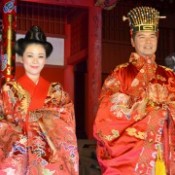
September 23, 2013 Ryukyu Shimpo
Selection of a new “king” and “queen” took place at the event “Mid-Autumn Feast” held in the Una forecourt of Shurijo Castle in Naha on September 22. Thirty five-year-old Masaya Koami was chosen in the role of “king” and Juri Shiohira as “queen.” Koami lives and works in Motobu and Shiroma in Itoman. Their first job will be to attend a swearing-in ceremony on October 26 in which the Sapposhi or envoy of the Chinese Emperor will bestow the imperial seal on the new King of the Ryukyu. They will also attend ancient-style processions, such as the one in which a scroll from the Ryukyu Dynasty is paraded through the streets on October 27. The new “king” and “queen” will take part in events hosted by Shurijo Castle Park over the next twelve months.
Dressed in a golden costume, the new “king” Koami said, “I am trying to carry myself like a king, and I want to convey our unique culture to people here in Okinawa and beyond.”
Shiohira said, “Tears of joy welled up in my eyes when I heard that I had been chosen as the new ‘queen.’ I had always wanted to do this role, so I am thrilled. I am very grateful to my mother and my friends for encouraging me.”
(English translation by T&CT, Mark Ealey)
Go to Japanese
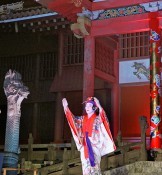
September 22, 2013 Ryukyu Shimpo
On September 21 and 22, the Mid-Autumn Feast held during the Ryukyu Dynasty was held in the Una forecourt of Shurijo Castle Park in Naha. On the opening day, four masters of the traditional performing arts who have the status of Living National Treasure of Japan appeared on the stage. They performed in front of the now-repaired pillars in front of the Seiden (State Hall). The scene was as though a feast to welcome envoys of the Emperor of the Chinese Dynasty was being held in the modern world.
Three masters Tokutaro Shiroma, Choichi Terukina and Kishun Nishie performed Akatafu-bushi, Niagishukwe-bushi and Niaginakafu-bushi with chanting and accompanied by the sanshin. Living national treasure Noho Miyagi performed the traditional dance Karaya, at the moonlight banquet, to a sanshin accompaniment and chanting by Terukina and Nishie. The audience was enthralled by the exquisite skill of their performance.
On the last day, kumi-odori traditional Okinawan musicals and ryubu traditional dance were performed. Selection was also carried out for the “King” and “Queen” to appear in the Shuri Castle Festival in October.
(English translation by T&CT, Mark Ealey)
Go to Japanese

Go To Video
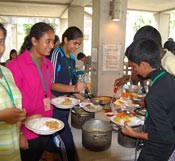
September 19, 2013 Hideaki Yoneda correspondent of Ryukyu Shimpo
The Asian Bridge Project between Sri Lanka and Okinawa was held from September 12 to 20 on Tokashiki Island. The National Okinawa Youth Friendship Center hosted this project commissioned by the Ministry of Education, Culture, Sports, Science and Technology. The project aims to deepen friendship under the theme of “Peace and Life” through exchange between groups of students.
Sixteen junior high school students from Sri Lanka, four staff, four Sri Lankan students studying in Okinawa and four Japanese tutors took part in the project, which was held for the fourth time this year. On Tokashiki Island, they enjoyed a variety of experiences and exchange activities held mainly at the National Okinawa Youth Friendship Center from September 15 to 17.
Sri Lankan students homestayed in the homes of students of Matsushima Junior High School in Naha. They visited Tokashiki with 13 students from Matsushima Junior High School. Both groups of students cooked Sri Lankan curry at the beach for lunch. In the evening, 10 students from Tokashiki Junior High School took part in the exchange meeting at the center.
They enjoyed the cross-cultural exchange, introducing their own schools and performing their own traditional dances. That night they stayed together. On the second day, in order to learn how precious human life is, they visited the site of a mass-suicide that occurred during the Battle of the Okinawa. After that they enjoyed marine sports at Aharen Beach and visited sightseeing spots on the island.
They experienced a lesson and interacted with students of Matsushima Junior High School during their homestay in Naha. On September 17, the Sri Lankan students also visited Shurijo Castle Park, the Peace Memorial Museum, Okinawa Churaumi Aquarium and looked at U.S. military bases. They returned to Sri Lanka via Narita on September 21.
A fifteen-year-old student said, “I am impressed with the kindness of the local people and the natural beauty of the blue sea and white sand of Tokashiki. When I return to home, I want to tell everyone about the culture of Okinawa.”
(English translation by T&CT, Mark Ealey)
Go to Japanese
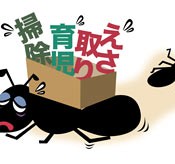
September 18, 2013 Ryukyu Shimpo
The research team from the University of the Ryukyus and the Japan Society for the Promotion of Science has found that ants that do not work actually live longer than those that do. The ants that live longer depend on those that work for them.
The research team found this example of what is called the public goods dilemma for the first time outside human beings and microorganisms. The public goods dilemma refers to a real-world decision whereby the result for any individual depends on the decisions of all involved parties. For example, these dilemmas involve decisions in which individuals must weigh up personal interests against the collective interest, which makes it difficult for societies to function.
The Proceedings of the National Academy of Science of the United States of America will publish the study results on its website.
One of the researchers, professor at the University of the Ryukyus, Kazuki Tsuji said, “The study results help us to understand why human beings help one another.”
In the experiment the researchers used the Japanese queenless ants called Pristomyrmex punctatus. They found ants that deposited eggs instead of working. The researchers confirmed that these were genetically different from those that work. The ants that do not work depend on the benefits created by those that work.
According to the study results, ants that go out of their nests and work have a lower survival-rate and die from overwork because they must cover those that do not work. Ants that do not work produce more offspring than those that work, but their children do not work either. In ant societies made up only of ants that do not work, those ants cannot produce offspring.
Despite it being possible to gain benefit within free competition by taking advantage of those who work for them there are people who help one another. Tsuji pointed out that it is an important topic in the fields of both natural science and social science. He said, “Understanding why ants help one another will lead to an understanding of why human beings help one another.”
(English translation by T&CT, Mark Ealey)
Go to Japanese








 Webcam(Kokusai Street)
Webcam(Kokusai Street)


